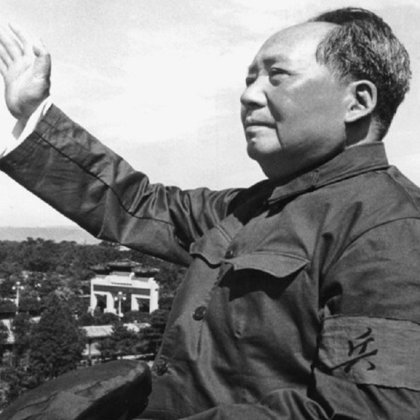MAO ZEDONG (1893 -1976 ) WAS A NATIONALIST ICON,HE WAS FOUNDED THE PEOPLE'S REPUBLIC OF CHINA AND LEADER OF THE REVOLUTIONARY VANGUARD IN THE COMMUNIST OF CHINA FROM ITS ESTABLISHMENT IN 1949 UNTIL HIS DEATH IN 1976.
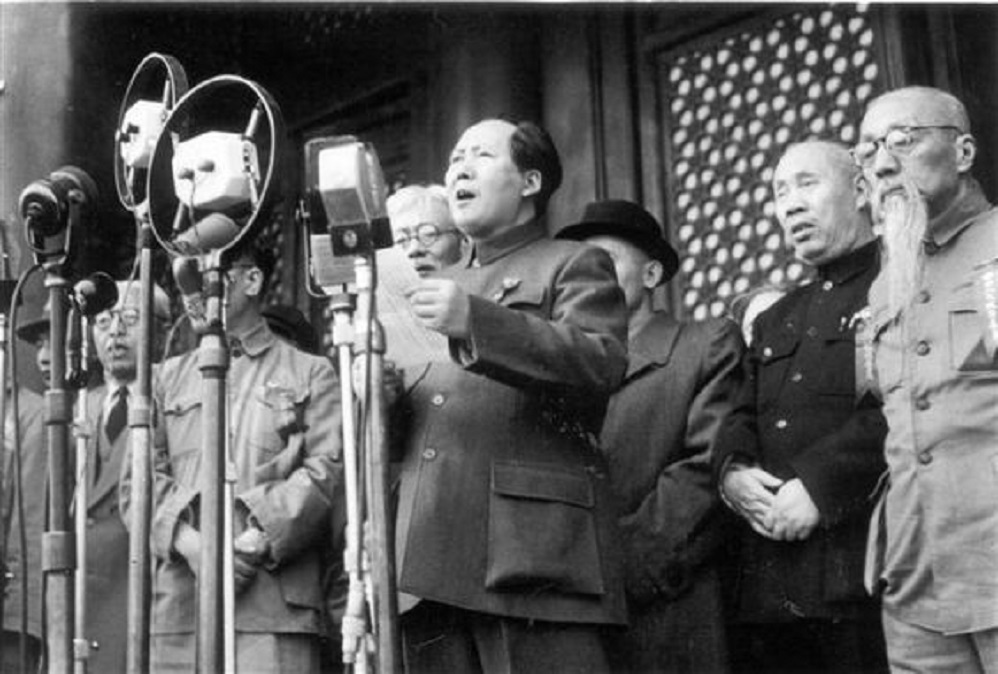 Mao and Chinese leaders at Tiananmen.Although the region now known as Inner Mongolia never left Chinese
control despite being partially occupied by Japan in World War II the
region’s successive inclusion in the Republic of China and in the
People’s Republic of China held rather different meanings to the
Mongols. In subscribing to the Moscow-inspired “national-liberation”
mode of ethnopolitical movement, most left-wing Mongol partisans
regarded the GMD phase of Inner Mongolia as a “pre-liberation” period in
which ethnic resistance was sanctioned by revolutionary forces in China
and the Soviet Union. During the Chinese Civil War and the early Cold
War years, however, leftist Inner Mongol autonomists were so deeply
engulfed by Moscow–Yan’an–Ulaanbaatar bloc politics that they could not
prevent the CCP’s class-based “national liberation” from trumping their
ethnonationalist movement. However reluctant, MPR leaders and most Inner
Mongol autonomists had to accept the establishment of the PRC as the
consummation of Inner Mongols’ “national liberation” as well.
Consequently, October 1 of 1949 marked the end of “national-liberation”
history for both the Chinese and the Mongols.
Mao and Chinese leaders at Tiananmen.Although the region now known as Inner Mongolia never left Chinese
control despite being partially occupied by Japan in World War II the
region’s successive inclusion in the Republic of China and in the
People’s Republic of China held rather different meanings to the
Mongols. In subscribing to the Moscow-inspired “national-liberation”
mode of ethnopolitical movement, most left-wing Mongol partisans
regarded the GMD phase of Inner Mongolia as a “pre-liberation” period in
which ethnic resistance was sanctioned by revolutionary forces in China
and the Soviet Union. During the Chinese Civil War and the early Cold
War years, however, leftist Inner Mongol autonomists were so deeply
engulfed by Moscow–Yan’an–Ulaanbaatar bloc politics that they could not
prevent the CCP’s class-based “national liberation” from trumping their
ethnonationalist movement. However reluctant, MPR leaders and most Inner
Mongol autonomists had to accept the establishment of the PRC as the
consummation of Inner Mongols’ “national liberation” as well.
Consequently, October 1 of 1949 marked the end of “national-liberation”
history for both the Chinese and the Mongols.
Mao Zedong was a communist dictator, and Chairman of the Communist Party of China. Under his rule tens of millions of people were killed, and persecuted. He caused the greatest famine in human history, cannibalism became rampant in some parts of China as a result, and he would execute people for the most minor of reasons. He destroyed Chinese culture and committed some of the worst human rights abuses in history. If the estimates of the deaths under him are accurate then he is responsible for the top incidence of excess mortality in human history. These are 10 shocking facts about Mao Zedong.Mao Zedong was an activist, a soldier and also the person who had a significant role in the establishment of the People’s Republic of China. He was an ambitious political genius who took the courage to protect China from the attack of foreign invaders and tried to help in industrial and agricultural growth of China. Mao Zedong was a visionary. After spending his childhood doing farming at his family owned lands, he joined China’s Communist party and started making histories.Initially, Mao used to support Chinese leader Sun Yat-sen.He used to support both the Kuomintang and the Communist Party in the beginning.He later became a follower of the Leninist ideas, where he believed farming peasants can help in communism in Asia. Mao didn’t have a very good relation with Chiang Kai-shek, who was the immediate in power after Sun Yat-sen and became the chairman in 1925 after his death.Chiang Kai-shek was very conservative by nature and Mao didn’t like his ideologies.Mao’s reforms were more liberal in the beginning. He launched Hundred Flowers Campaign in 1956 which offered freedom of opinions and allowed others to express their thoughts.Unfortunately, his campaign didn’t do very well as it saw less response and he had to face vast criticism from the urban people. He began to fear about losing power and control and immediately labelled thousands of Chinese “rightists”.Although Mao’s new campaign Great Leap Forward was directed toward agricultural and industrial production improvement, the result wasn’t great because of floods and bad harvests. Not only that, even the news of massive industrial production appeared false.Between 1959 and 1961, the whole country went through a severe loss as around 40 million people died of hunger.Some people believed that Mao had the spirit to drive a revolution, but didn’t have the ability to run a country.Many of the Mao inspired revolutions destroyed country’s national heritage and created economic and social mess countrywide.Some of his critics also said that Mao created a false crisis that only he could solve.Mao lost most of his powers due to bad decisions and dirty politics. It was the year 1972 when he again tried to restore his position.This was the time when he tried US-China collaboration to ease the relation and stabilize the tensions going on between the two countries.By that time, Mao’s health was already worsening. It was the reason he couldn’t stand strong on his words and made his statements clear during official meetings.Under Mao the starvation got so bad that the government had to put up propaganda posters to convince people not to eat their children. The famine lasted three years, and was caused by the Great Leap Forward. Historians disagree over how many people died due to the famine, historian Frank Dikotter, estimated that there were 45 million premature deaths from 1958 to 1962. The Great Leap Forward was a social, and economic plan instigated by Mao Zedong. The plan was to transform China from an agrarian economy into socialist society. He tried to achieve this by quickly industrialising the economy, and collectivisation. Lower-end estimates put the death toll at 15 million, and higher end estimates put it at 55 million.
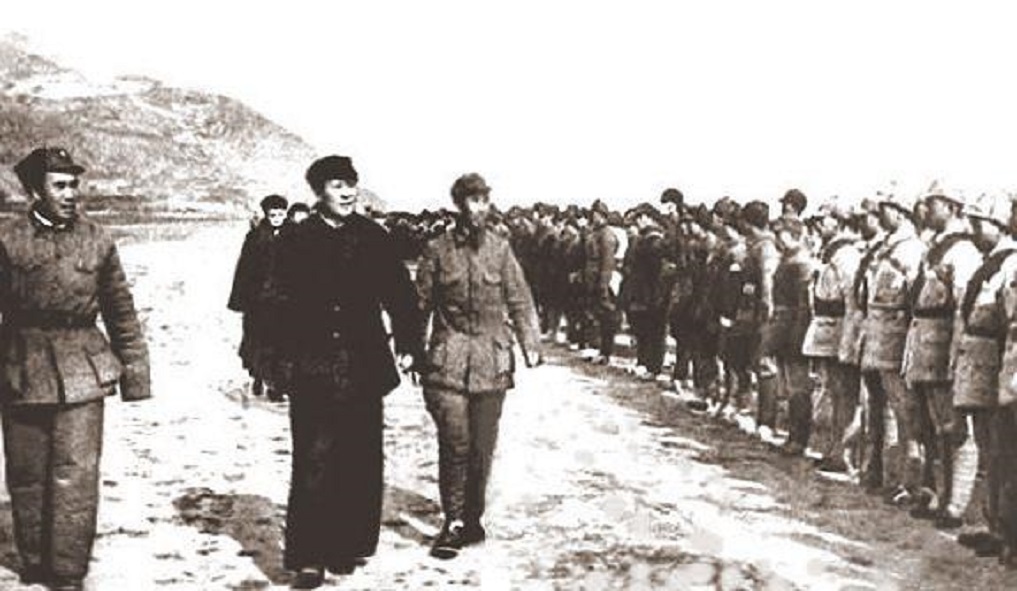 The Long March of 1935 can be compared with the Dunkirk evacuation and the Cuban Missile Crisis . The after effects reverberated on for 50 years and shaped China's position in the world. Although historians can agree on its importance, there the unanimity ends, the facts of the Long March continue to be hotly debated.By dogged determination and sheer good luck the Communists escaped their doom, surrounded and outnumbered at the Jiangxi Soviet to arrive at Shaanxi as war-hardened leaders to drive forward Communist Party policy for fifty years. The veterans of the Long March held the reins of power for the rest of their lifetimes and gave an outward show of solidarity and unity that gave China much needed stability and a springboard for rapid economic development. Shared hardship forged bonds of loyalty and understanding. Just as importantly Mao Zedong emerged from the Long March as a wily and effective leader who went on to lead the party and then the country for 35 years without any serious opposition.
The Long March of 1935 can be compared with the Dunkirk evacuation and the Cuban Missile Crisis . The after effects reverberated on for 50 years and shaped China's position in the world. Although historians can agree on its importance, there the unanimity ends, the facts of the Long March continue to be hotly debated.By dogged determination and sheer good luck the Communists escaped their doom, surrounded and outnumbered at the Jiangxi Soviet to arrive at Shaanxi as war-hardened leaders to drive forward Communist Party policy for fifty years. The veterans of the Long March held the reins of power for the rest of their lifetimes and gave an outward show of solidarity and unity that gave China much needed stability and a springboard for rapid economic development. Shared hardship forged bonds of loyalty and understanding. Just as importantly Mao Zedong emerged from the Long March as a wily and effective leader who went on to lead the party and then the country for 35 years without any serious opposition.
Mao was a womaniser who would often cheat on his wife. He even entered into a relationship with a 14 year old ballet dancer. She was part of a dance troupe meant to entertain soldiers, but sometimes Mao would invite back dancers to “make him his tea”. The girls parents were furious when they found out the 69 year old Mao, had made their daughter his mistress, but there was nothing they could do. Their relationship continued for 5 years until his wife became jealous and forced him to leave her.Mao grew up as part of a peasant family, living in small village. His father was a wealthy farmer, and they were the richest people in the village. They managed to afford to send him to school where he became a nationalist, anti-imperialist. He was a smart student but was unruly, and ended up being kicked out three times. The Mao family lived in luxury compared to those around them, but that didn’t stop him from being mocked by the other students for his ragged peasant clothes.In 1957 Mao announced the Hundred Flowers Campaign. He encouraged people to offer criticism of his government and policies as long as they also offered solutions. Doing this he convinced thousands of people to speak out against him, and offer different solutions. A year later he rounded up 550,000 people who criticised the government. Mao Zedong had actually just laid a trap to try and find out who the intellectuals that disagreed with him were. He described it as enticing the snakes from their lairs. The 550,000 people were either sent to labour camps, reeducation camps, or executed.Mao Zedong hated toilets, and would only use a hole in the ground to relieve himself. He thought that toilets smelt bad, and that the smell would hurt his brain. If he had to go to the toilet, he would just head out to the woods and go there. He would force one of his bodyguards to dig him a hole out there, and then guard him while he went.In a province called Guanxi, cannibalisation become a huge problem. Communists began eating people in order to prove their dedication to communism. They would stalk people in large crowds and then attack them ravenously. Sometimes victims would be skinned alive and castrated before being killed. Eating people wasn’t looked down upon, and was something people did with their friends and family; they were proud of it. One old lady was famous for gouging out people’s eyeballs and eating them. The communist government tried to cover up what was going on there. It didn’t just happen in Guanxi though, all over China people began eating their relatives, and even their children out of starvation.When Mao was presented with mangoes by the Pakistani foreign minister, he called the mangoes a “spiritual time bomb”. He had the mangoes sent to propaganda teams across China. The propaganda teams starting writing ridiculous newspaper articles about the mangoes like this one:“In the afternoon of the fifth, when the great happy news of Chairman Mao giving mangoes to the Capital Worker and Peasant Mao Zedong Thought Propaganda Team reached the Tsinghua University campus, people immediately gathered around the gift given by the Great Leader Chairman Mao. They cried out enthusiastically and sang with wild abandonment. Tears swelled up in their eyes, and they again and again sincerely wished that our most beloved Great Leader lived then thousand years without bounds … They all made phone calls to their own work units to spread this happy news; and they also organised all kinds of celebratory activities all night long, and arrived at [the national leadership compound] Zhongnanhai despite the rain to report the good news, and to express their loyalty to the Great Leader Chairman Mao. “ Mao made the offer at a meeting with US national security advisor Henry Kissinger. The offer drew laughter from officials at the meeting, and Kissinger joked that the US did not have any quotas or tariffs for imported Chinese women. He later added, “It is such a novel proposition, we will have to study it.”The assistant Chinese foreign minister warned Mao if the offer ever became public knowledge “it would incur the public wrath.” Mao said he wasn’t worried because he didn’t expect to live much longer anyway, saying “God has sent me an invitation.” Mao died three years later. Mao’s offer only became known to the public in 2008 when the US State Department released documents about the meeting.In 1973, Mao purposed exporting Chinese women to the United States. At first, he offered to send “thousands” of women and later upped the offer to 10 million. Mao believed sending the women would lead to bilateral trade between the two countries and would also ease China’s overpopulation problems. He said China was a “very poor country” and “what we have in excess is women.
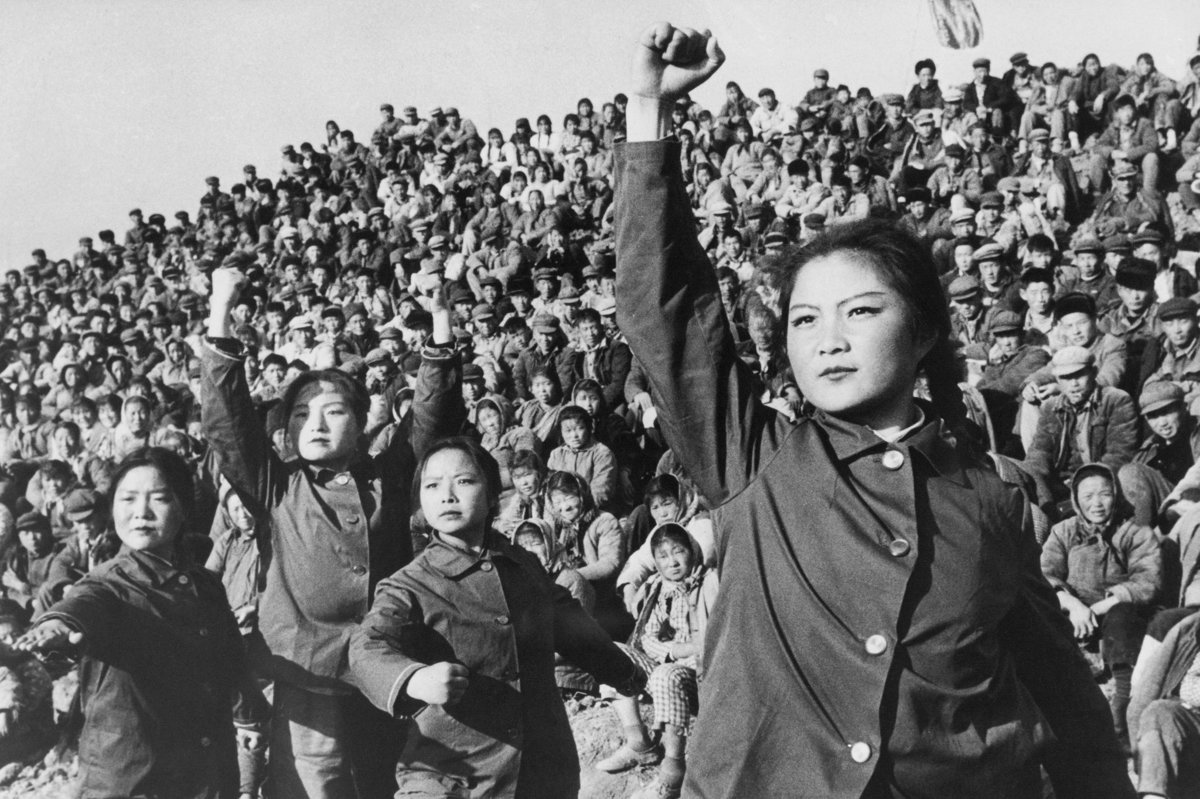
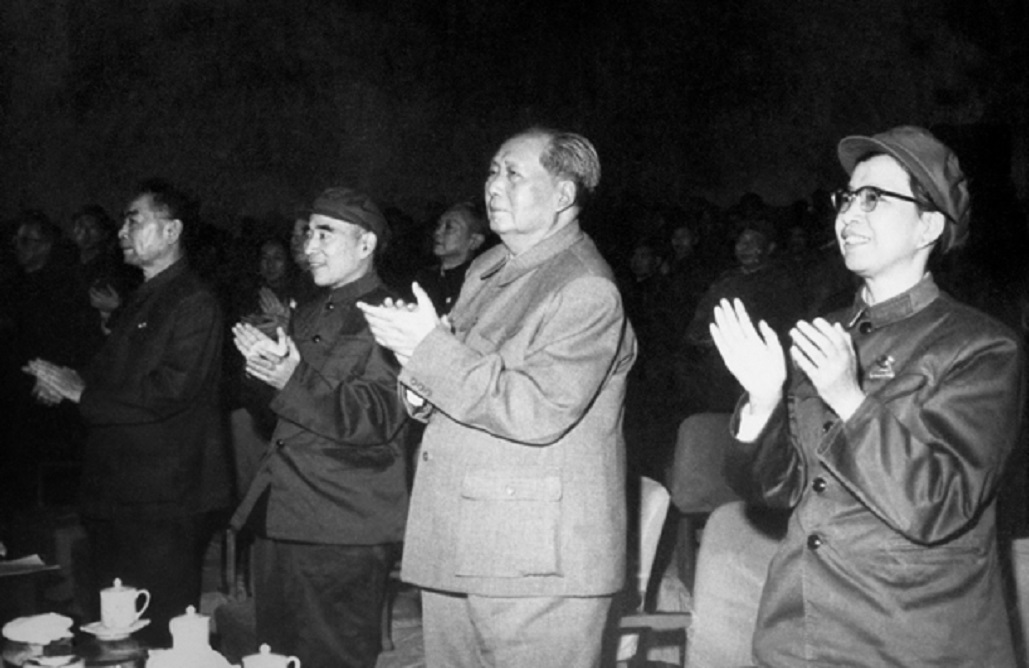 What was the Cultural Revolution? Young people battled Mao’s
perceived enemies, and one another, as Red Guards, before being sent to
the countryside in the later stages of the Cultural Revolution.
Intellectuals, people deemed “class enemies” and those with ties to the
West or the former Nationalist government were persecuted. Many
officials were purged. Some, like the future leader Deng Xiaoping, were
eventually rehabilitated. Others were killed, committed suicide or were
left permanently scarred.
What was the Cultural Revolution? Young people battled Mao’s
perceived enemies, and one another, as Red Guards, before being sent to
the countryside in the later stages of the Cultural Revolution.
Intellectuals, people deemed “class enemies” and those with ties to the
West or the former Nationalist government were persecuted. Many
officials were purged. Some, like the future leader Deng Xiaoping, were
eventually rehabilitated. Others were killed, committed suicide or were
left permanently scarred.
One of Mao’s first plans was land reform. Utilizing the massive number of peasants in poverty, Mao ordered that in every village, at least one landlord was to be executed as an example, and that all the property was to be equally redistributed. Although this did help to close the massive income and social disparity in China, it did so at the cost of millions of lives. In addition, Mao continued to cement his political and economic control of the nation through the “Campaign to suppress counter revolutionaries”. Although this campaign was provoked by Nationalist remnants who tried to foster armed rebellion and conduct acts of terrorism such as sabotaging rail lines and buildings and stealing cattle and animals, it grew to target anyone who opposed Mao and the Communist Party. The campaign altered between lenient punishments to assuage the public, but also mass executions when Mao felt that the Nationalist influence grew too strong. This would later pave the way for the Anti-Rightist movement and the Cultural Revolution, both of which were targeted to Mao’s opponents.Mao’s next policy was to try and improve China’s economic capability through what would come to be known as “The Great Leap Forward” Mao demanded that large farming communes would be formed, and that private land ownership would be banned. In addition, he advocated the U.S. of furnaces that were not properly fueled to turn scrap metal into usable material, which became a miserable failure. In order to meet the man-power requirements of his ideas, he diverted factory workers and others to work on the communes and in the production of iron. Furthermore, Mao utilized untested and theoretical planting techniques, such as over-seeding of the same plant type, deeper planting for supposedly “better root growth”, and concentration of fertilizer on one type of ground while not planting other areas. All of these policies were eventually proved to be faulty, and combined with ecological disaster, crop growths dropped by a huge amount. However, low-level communist leaders, both fearful of being targeted for a failure to meet goals, and excited for a chance to move higher on the Communist totem pole, lied and exaggerated grain and food production. As a result, the government took food for export even when the farmers themselves had nothing to eat, resulting in mass famine. In the end, “The Great Leap Forward” turned out to be a massive step backwards.However, Mao, unlike other leaders who would ignore their mistakes, Mao would fix the problems when he realized there was one. For example, when he realized that the home-made furnaces were useless, he discontinued them and moved to formal furnaces powered by coal. In addition, he also admitted that the Great Leap Forward had been a mistake, and allowed his subordinates to import grain and give some private land ownership. Unlike other dictators who would never acknowledge that they were wrong, despite the deaths of their citizens, Mao admitted that he was wrong and would attempt to change for the better.One thing Mao was able to do that greatly assisted China was that he turned to the future and replaced the corrupt and inept Qing dynasty. Also, he drove out the Nationalists, who were responsible for brutal killings and were essentially tyrants without the support of the people. Also, he righted the massive income disparity in China where the wealthy had an enormous amount of wealth and power while the poor farmers and workers had nearly nothing. This allowed China to start over anew, and to move forward as an entire nation, not just the privileged upper class leaving the lower class behind like other 3rd world or 2nd world nations.Another thing Mao did do well was to empower China as an independent nation. Previously, China had been extremely weak to the outside world. So-called Western “democracies” would often use a better equipped army to force open unfair trade routes or make money in other unfair ways. Also, England used its superior military to win the Opium war. However, under Mao, despite the fact that China was still economically and technologically behind other nations, Mao was able to create an army that stalemated one of the world’s superpowers, the U.S. Also, during this time period, undue foreign influences greatly diminished, and China’s military strength grew greatly, becoming one of the nations to have successfully detonated the Atomic bomb. Mao was able to make China a powerful military nation capable of defending itself against outside invaders, something that no previous imperial dynasty had been able to successfully accomplish.Despite Mao’s failures, he did manage to unite the country as one and to start the process of bringing China up to speed with the rest of the world. He built up an industrial force by forcing people to work on factories and farms. As a leader and a motivator, he was able to spurn his nation into attempting to increase production and becoming superior to the Western nations. However, as a Chairman who frequently felt threatened by others, he also initiated many violent movements to cement his control of the Communist Party and of an entire nation. Mao Zedong laid the foundation for China to come onto the world stage, and Deng Xiaoping and other reformers built upon that foundation to create the economic and political skyscraper China is today.
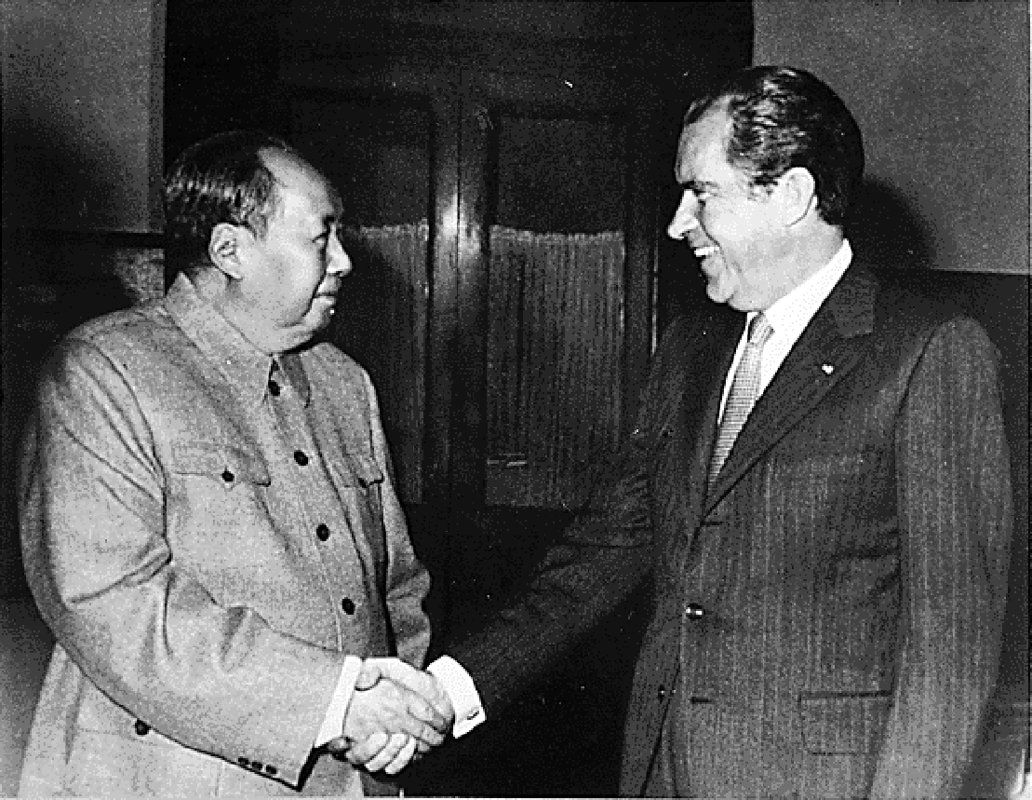 President Richard Nixon and his wife traveled in a landmark visit to
the People's Republic of China in February 1972. The trip would begin a
new period of Chinese-American relations. Nixon's visit was a strategic
maneuver made after relations between the West and the Communist East
were gradually changing. China had publicly disagreed and split from the
Soviet Union. Nixon used this confrontation, which was peaking in the
early 1970s, to make a visit that would stun the world.The picture of Richard Nixon, a virulent anti-Communist since his
time as a Congressman during the Alger Hiss case, shaking hands with the
leader of Communist China was one most never imagined they would see.
The handshake was of particular importance to Nixon as he was told that
John Foster Dulles's decision not to shake hands with Zhou Enlai had
left him insulted. Nixon wanted the visit to be a picturesque message
sent around the world, preferring cameramen to reporters covering the
event.
President Richard Nixon and his wife traveled in a landmark visit to
the People's Republic of China in February 1972. The trip would begin a
new period of Chinese-American relations. Nixon's visit was a strategic
maneuver made after relations between the West and the Communist East
were gradually changing. China had publicly disagreed and split from the
Soviet Union. Nixon used this confrontation, which was peaking in the
early 1970s, to make a visit that would stun the world.The picture of Richard Nixon, a virulent anti-Communist since his
time as a Congressman during the Alger Hiss case, shaking hands with the
leader of Communist China was one most never imagined they would see.
The handshake was of particular importance to Nixon as he was told that
John Foster Dulles's decision not to shake hands with Zhou Enlai had
left him insulted. Nixon wanted the visit to be a picturesque message
sent around the world, preferring cameramen to reporters covering the
event.
The Cultural Revolution was started by Mao Zedong, he thought that it would unseat the ruling class. This involved the purging of capitalists, and traditionalists, and eventually liberals. In 1996 Mao launched the revolution. He forced his opponents out of the Communist Party of China by calling for a class struggle. People all over China responded to his call, and set up groups of Red Guards. The idea infected not just the minds of the people, but the military and government as well. It resulted in violent outbreaks all over China.Millions of people were persecuted in the events that followed. People were subject to public humiliation, arbitrary imprisonment, torture, hard labour, and execution. The movement held the country back politically, and greatly damaged it’s economy. It’s been described as one of China’s greatest setbacks. It lasted for 10 years from 1966 to 1976, and only ended once Mao had been killed.Four people in particular became prominent during the Cultural Revolution, for their treacherous crimes. When they finally died, people celebrated in the streets. They were communist politicians, and Mao fanatics. The group was made up of Jiang Qing (Mao’s wife), Zhang Chunqiao, Yao Wenyuan, and Wang Hongwen. Yao Wenyuan is reported to have started the Cultural Revolution by writing an article, which criticised an opera, which he claimed was attacking Mao, in a subtle way. The gang then put on Operas glorifying Mao, and the People’s Liberation Army. These plays eventually were also printed on comic books, posters, postcards, stamps, and many more kinds of merchandise.In order to achieve collectivisation he tortured and humiliated anyone who tried to dissent. This was done through “Struggle sessions”. The victim of the struggle session would stand in front of a crowd and be accused of crimes. The crowd would verbally, and physically attack the victim until he admitted to the crimes he was accused of of. This would often be done at the victims place of work, but sometimes would be held in sports stadiums, where tens of thousands of people could take part. Mao Zedong claimed that the struggle session was actually meant to benefit the victim, by cleansing him of any counterrevolutionary thinking.During the visit to Moscow, Mao had expected to be treated as a guest of honor. So he considered it an insult when he was given the same treatment as the many other guests who were there to celebrate Stalin’s 70th birthday. For instance, he was only allowed a short meeting with Stalin.So when Khrushchev visited China, Mao took his revenge in several ways. They included housing Khrushchev in an old hotel with no air-conditioning, and chain-smoking during their meetings because he knew Khrushchev hated it. When Mao insisted they hold a meeting in his pool, Khrushchev stayed in the shallow end and Mao swam laps. Mao then suggested Khrushchev join him in the deep end, and he was provided with a flotation device. Observers said Khrushchev still struggled to stay afloat.In Khrushchev’s memoirs, he tried to play down the humiliating event, writing “of course we could not compete with him when it came to long-distance swimming” and that “most of the time we lay around like seals on warm sand or a rug and talked.”But later, in a speech to a group of artists and writers, Khrushchev was more honest about the incident. “Between us, I basically flop around when I swim. I’m not very good at it. But he swims around, showing off, all the while expounding his political views. It was Mao’s way of putting himself in an advantageous position.
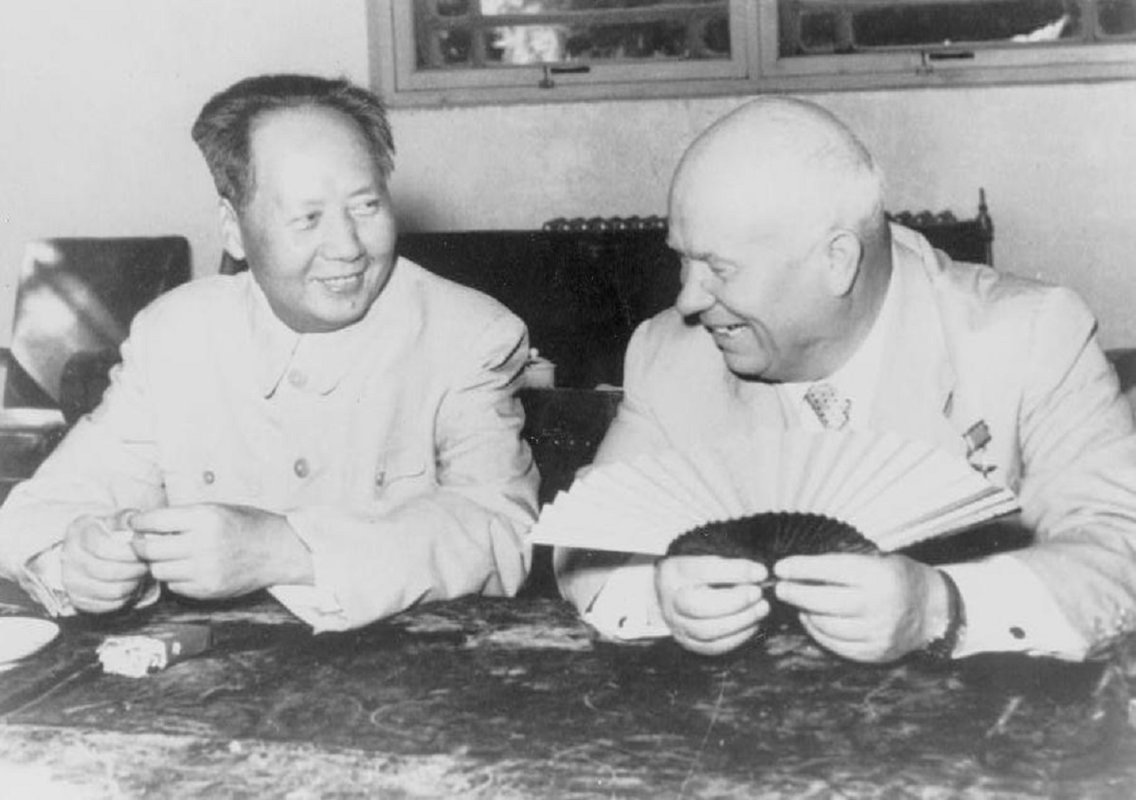 Chinese leader Mao Zedong with Soviet leader Nikita Khrushchev in August 1958.Soviet leader Nikita Khrushchev visited
China at the end of September 1959 to hold a summit with the Chinese
leadership. A little over a month earlier, several Indian guards had
been killed by the Chinese military along their disputed border.Khrushchev, who was about to visit the United
States on a peace mission when the killings happened, released an
announcement through the Russian news agency, TASS, calling on both
sides to reach a negotiated settlement. The Chinese were greatly
offended, seeing it as more evidence of the Soviets breaking ranks with
their communist partners.Khrushchev’s visit to China also came just months after the Dalai Lama had fled to India.
Chinese leader Mao Zedong with Soviet leader Nikita Khrushchev in August 1958.Soviet leader Nikita Khrushchev visited
China at the end of September 1959 to hold a summit with the Chinese
leadership. A little over a month earlier, several Indian guards had
been killed by the Chinese military along their disputed border.Khrushchev, who was about to visit the United
States on a peace mission when the killings happened, released an
announcement through the Russian news agency, TASS, calling on both
sides to reach a negotiated settlement. The Chinese were greatly
offended, seeing it as more evidence of the Soviets breaking ranks with
their communist partners.Khrushchev’s visit to China also came just months after the Dalai Lama had fled to India.
To policymakers in the West who in the early Cold War years viewed the communist bloc as a monolith, this estimate by the CIA constituted a fundamental change of perceptions. But what “Chinese nationalism” revealed in Beijing’s Cold War diplomacy was much more complex than that demonstrated in the Sino-Soviet rupture. Before treating China as a participant in modern international affairs, we must recognize that in the 19th century and the better part of the 20th century China was a national state in the making. In shaping that process, China’s inter-ethnic affairs in Inner Asia were as vital as China’s international relations in East Asia. Events along China’s northern and western frontiers should not be just concerns of specialists in Mongolian and Tibetan studies. They belong to the pages of international history. In the mid-19th century, imperialist incursion coming from the West threw the Qing Empire into a whirlpool of violent transition but by no means severed the connections between the empire’s Han and non-Han constituencies. As shown here, the Mongols and the Tibetans have occupied significant positions in China’s twentieth century transformation, within which Communist rule in China after 1949 was but one stage. Therefore, any consideration of Chinese nationalism cannot afford to let its international entanglement obscure its inter-ethnic politics. The two aspects are invariably intertwined. During the Qing Dynasty, Mongolia and Tibet were tied together in the Manchus’ imperial management through their mutual military and religious influence, and the military role of the Mongols in the service of the empire. The Mongolian–Tibetan enterprise was central to the Manchu effort to maintain a delicate balance of ethnic-power within China. During the 20th century, however, the two regions became politically disassociated. The administrative conception of “Mongolian–Tibetan Affairs” in the Republic period mainly meant that both regions were “special,” which was to say that neither was effectively controlled by China’s weak central regimes. Whereas the Russians used force to consolidate control over their protectorate in Outer Mongolia, the British were satisfied with a balancing position in Tibet to contain Chinese efforts to assert sovereignty there. Both the Russian and British approaches were typical buffer strategies of the imperialist age, and together they unseated the dependency management of the Qing Empire and undercut the historical connections between Tibetan and Mongolian politics. Yet in the meantime these strategies had rather different impact on 20th-century Chinese politics and the macro-historical transformation of Chinese territoriality. The experience of the Chinese Communist Party best illustrates how British and Russian influence in the two ethnic frontiers impinged on China’s revolutionary history. In the course of its Long March in the 1930s, the CCP turned away from Tibet, a land under Western imperialist influence, and struck out toward Mongolia, a territory under communist control. This illustrates how political ideologies and divisions affected East Asian geopolitics long before the Cold War started. Yet, in 1949, when the CCP ascended to power and began to patch together the territorial pieces that had once constituted the Chinese empire, geopolitics reasserted itself with a vengeance. However, coming to power in 1949 and establishing the China-Soviet alliance in 1950, the CCP was forced to accept the permanent separation of the Mongolian People’s Republic from China. Their liberation enterprise managed to rein in only the “inner” part of Mongolia, which would serve as an ethnopolitical model for the CCP’s “liberation” of Tibet. After 1949, Beijing’s policies toward Tibet, India, the United States, and the Soviet Union may be understood at once as the CCP’s response to the changing contours of the Cold War and as the historical steps of China as a national state. In the latter frame of reference, Beijing’s Tibetan and Indian problems were equally about the establishment of China’s “domestic sovereignty” and the demarcation of China’s “geo-body”; its dealings with the United States and the Soviet Union reflected China’s normative stance in mediating between two opposing international societies and two political blocs. The ascendance of a communist movement to power in China, the rise of India as a newly independent national state, the continuation of Tibet’s unique culture and aristocratic-religious systems, and the entry of the United States as a destabilizing foreign influence—all these forces converged on Tibet in the 1960s. The result could only be an extremely complex, confusing, and tangled contest. In this contest the PRC managed to preserve its sovereignty in Tibet, but at the price of being forced to give up its initial intention to ground Chinese rule on inter-ethnic harmony in the region. In the short run, the ensuing deterioration of the Sino-Indian relationship seems to have been caused by the two governments’ disagreement about how their common borders should be drawn. In the longer historical perspective, however, the dispute actually reflected a “progress” in the two countries’ bilateral relationship, from imperial to national.
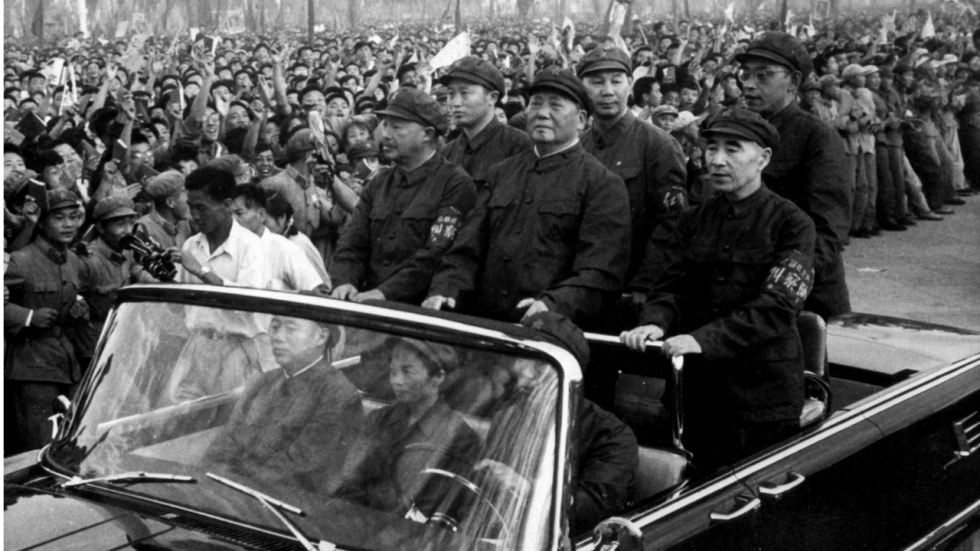 The ambivalent relationship between Communist Party leader Mao Zedong
and the man he picked to succeed him, Lin Biao, has led to a lot of
speculation and conspiracy theories regarding the aircraft crash that
claimed Lin’s life.Some said it crashed in eastern Mongolia after being shot down by a
land-to-air missile launched by either Chinese or Soviet forces, rather
than running out of fuel, as claimed by Beijing in 1971.
The ambivalent relationship between Communist Party leader Mao Zedong
and the man he picked to succeed him, Lin Biao, has led to a lot of
speculation and conspiracy theories regarding the aircraft crash that
claimed Lin’s life.Some said it crashed in eastern Mongolia after being shot down by a
land-to-air missile launched by either Chinese or Soviet forces, rather
than running out of fuel, as claimed by Beijing in 1971.
Beijing’s “reforms” in Tibet after 1959 injected communist ideology into the Buddhist society. Chinese expansion into Tibet did not provoke the United States to act as it did in Korea, Vietnam, and the Taiwan Strait through direct confrontation and overt military intervention. Leaving aside other reasons, Washington’s choice of a limited secret CIA war rather than open warfare should be understood in part in light of the fact that Beijing’s consolidation of “domestic sovereignty” in Tibet did not violate the established international norm of differentiating domestic from foreign affairs. Beijing’s abrogation of the Tibetan status quo ended the last historical legacy of the late Qing’s “loose-rein” type of “dependency” policy. China took one more stride in nationalizing territoriality and thereby assumed a position comparable to that of European or American actors in the international scene. China’s “becoming national” was completed at a time when enemies and friends in international politics were identified in popular understanding in terms of supranational ideologies. Ironically, it was China’s supposed socialist ally, the Soviet Union that openly questioned Beijing’s Tibet policy and the anti-Indian consequences. As indicated in the Mao-Khrushchev quarrels over Tibet and India, the so-called principled basic line of the PRC diplomacy was framed by a national-state temperament that had taken shape since the 19th century, overshadowing the claims of communist ideology and fraternity. This paved the way for the China-Soviet conflict of the 1960s and China’s “tacit alliance” with the United States from the 1970s. Also at work was a more profound historical logic China’s normative direction in international relations already afoot long before these events. A last word concerns the surprising roles that Mongolian and Tibetan affairs have played in Cold War international history. After the Opium War, in the wake of China’s defeat, Wei Yuan used his Haiguo Tuzhi (Maps and records of ocean states) to direct the attention of China’s national defense from Inner Asia to the new threat from the Pacific. Then, the Russian and British efforts to control Mongolia and Tibet as part of their imperial management succeeded in different degrees in severing these territories’ connections with China. Studies of 20th-century Chinese foreign relations and political history have given minimal attention to developments in China’s western and northern borderlands. This paper has shown that the settlements of the Mongolian and Tibetan questions around and after the mid-20th century were not only central to the territorial and ethnographic formation of China as we know it today; they also constituted major threads in the fabric of international power relations. From Beijing’s perspective, the 1951 arrangements served the purpose of ushering Tibet gradually toward its socialist transformation and for transition to the central government’s complete “domestic sovereignty.” There is evidence that as early as in 1956 and 1957 leaders in Beijing were quite optimistic and started to encourage its Tibetan Working Committee to initiate reforms in Tibet. Yet when full-scale preparations for reforms caused strong objections among the Tibetan aristocracy, Beijing ordered the working committee to beat a speedy retreat. At the same time Beijing promised Tibetan leaders that there would be “no reforms for the next six years.” In response, opponents of reform raised a demand for “no reforms for ever” and asked all Han to leave Tibet. About two months prior to the Lhasa incident, Mao apparently had lost patience with the “Dalai line.” Now he held that “a general showdown will be necessary.” Noting the presence of rebels in the Lhasa area, Mao pointed out that this was a good thing “because now war can be used to solve the problem.” Such thinking clearly jettisoned the one country-two systems formula.
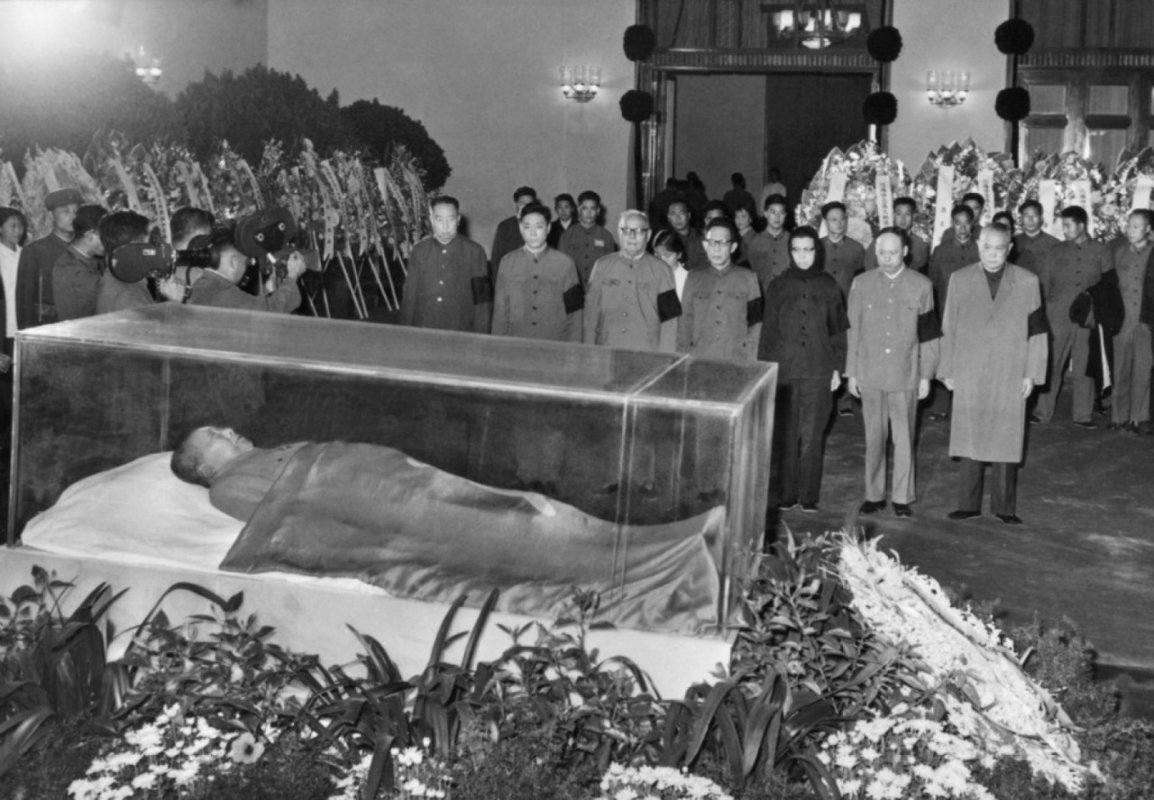 1976 September 9th Mao Zedong dies, grief throughout China .1976
September 9th, 10 minutes past the midnight, Mao Zedong departed from
this world. September 18th, representatives from the capital and other
regions of the country paid their last respects to Chairman Mao. Textile
women in the capital, when faced with the remains of Chairman Mao,
cried in deep grief.
1976 September 9th Mao Zedong dies, grief throughout China .1976
September 9th, 10 minutes past the midnight, Mao Zedong departed from
this world. September 18th, representatives from the capital and other
regions of the country paid their last respects to Chairman Mao. Textile
women in the capital, when faced with the remains of Chairman Mao,
cried in deep grief.
 The ambivalent relationship between Communist Party leader Mao Zedong
and the man he picked to succeed him, Lin Biao, has led to a lot of
speculation and conspiracy theories regarding the aircraft crash that
claimed Lin’s life.Some said it crashed in eastern Mongolia after being shot down by a
land-to-air missile launched by either Chinese or Soviet forces, rather
than running out of fuel, as claimed by Beijing in 1971.
The ambivalent relationship between Communist Party leader Mao Zedong
and the man he picked to succeed him, Lin Biao, has led to a lot of
speculation and conspiracy theories regarding the aircraft crash that
claimed Lin’s life.Some said it crashed in eastern Mongolia after being shot down by a
land-to-air missile launched by either Chinese or Soviet forces, rather
than running out of fuel, as claimed by Beijing in 1971.